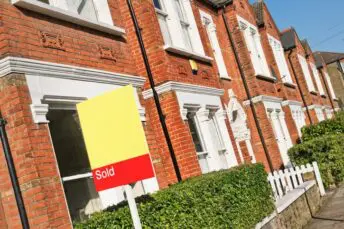House Price Watch Apr 2023
The housing market continues to experience a readjustment in house prices as annual house price growth slows to 0.9%. However, the market is showing signs of stabilising, particularly among first time buyers weighing up the cost of renting, as mortgage rates begin to settle around 4-5%. Even so, with mortgage rates double where they were a year ago, and average earnings below the level of inflation, we still expect a slower period for the housing market and further price adjustment in the months ahead.
What’s happening nationally
House prices are down on average -0.3% in the past month and annual house price growth has slowed to +0.9%.
The indices are showing a range of house price movements over the past month. Halifax and Land Registry are showing a drop, while Nationwide and Rightmove, saw house prices increase in April.
Indices based on:
Land Registry – registered property transactions in March.
Nationwide & Halifax – mortgage valuations in April.
Rightmove – asking prices posted on Rightmove in April.
*Rightmove is not included in the index average as the basis for its index is different (asking price vs agreed sale price)
| Index reports: | Monthly change | Annual change |
|---|---|---|
| Land registry | -1.2% | +4.1% |
| Nationwide | +0.5% | -2.7% |
| Halifax | -0.3% | +1.3% |
| Rightmove | +0.2% | +1.7% |
| Average change | -0.3% | +0.9% |
House prices in your area
House prices have fallen over the past month in all areas except Scotland. The fastest rate of annual house price growth is in the South West (+5.4%) and North West (+5.2%) and the slowest in London (+1.5%).
Average house prices are highest in London (£523K) and lowest in the North East (£157K).
House price growth varies somewhat by property type. Detached (+5.3%), semi detached (+4.8%), terraced (+3.0%) and flats/ maisonettes (+3%) according to March Land Registry data.
| UK Region | Average price £ | Monthly change | Annual change |
|---|---|---|---|
| England | |||
| Nothern Ireland | |||
| Scotland | |||
| Wales | |||
| North West | |||
| Yorkshire and The Humber | |||
| North East | |||
| West Midlands | |||
| East Midlands | |||
| South West | |||
| East of England | |||
| South East | |||
| London |
| UK City | Average price | Annual change |
|---|---|---|
Market Monitor
There were 90K transactions in March, up 1% on February 2023 but 19% lower than March 2022. 90K transactions is below the usual level for this time of year based on recent years.
Demand continues to fall and new instructions from sellers are also down this month. Average stock per agent is up slightly month on month and speed of sale has improved slightly.
Time to sell 55 days, improved on recent months, but slower than the average of 40 days over the last 12 months.
How busy is the market?
- Not busy
- Normal
- Very busy
- Transactions up slightly in March, below typical transactions for this time of year
- Total transactions in March 90K
- +1% from last month
- -19% from March last year
Homes for sale vs homebuyers
- Good availability of homes
- Normal
- Shortage of homes
- Buyer enquiries continue to fall(-37% RICS); twelfth monthly drop
- Seller enquiries down (-19% RICS)
- Average stock per agent 45; up from 43 last month (incl under offer/ Sold STC Rightmove)
Average speed of sale
- Fast
- Normal
- Slow
- 55 days to find a buyer down from 57 days (12 month average 40 days Rightmove)
What the experts say
Rightmove - agent's view

“The average price of property coming to market rises by just 0.2% (+£890) this month, lower than the average of 1.2% at this time of year, as new sellers heed their agents’ advice to price cautiously and tempt Spring buyers. Despite the economic headwinds, first-time-buyer type properties hit a new record price this month. Faced with record rents, buying is still compelling for those first-time buyers who are able to clear the mortgage and deposit hurdles. The average first-time-buyer mortgage rate for a 5-year fixed, 15% deposit mortgage has now fallen to 4.46%, with the lowest rate for this mortgage type currently at 4.19%. Sales agreed numbers recover to be in line with the more normal pre-pandemic market of March 2019 but 18% behind last year’s exceptional market as we transition to a more normal level of sales activity.”
Nationwide

“While annual house price growth remained negative in April, there were tentative signs of a recovery with prices rising during the month. April’s monthly increase follows seven consecutive declines with prices 4% below their August 2022 peak. Bank of England data suggests housing market activity remained subdued in the opening months of 2023, with mortgages approved for house purchase in February almost 40% below the level a year ago, and around a third lower than pre-pandemic levels. However, in recent months industry data on mortgage applications point to signs of a pickup. This also chimes with shifts in consumer sentiment. While confidence remains subdued, people’s views of their own financial position over the next twelve months, and general economic conditions in the year ahead, have improved in recent months. But it will take time for household finances to recover, since average earnings have been failing to keep pace with inflation. Mortgage interest rates are also likely to act as a headwind, rates are still more than double the level prevailing a year ago.”
Halifax

“The rate of annual house price inflation slowed further meaning average property prices are largely unchanged from this time last year. A typical property is now around £7,000 below last summer’s peak, though still some £28,000 higher than two years ago. Mortgage rates are now stabilising, and though they remain well above the average of recent years, this gives important certainty to would-be buyers. Alongside a market-wide uptick in mortgage approvals, these latest figures may indicate a more steady environment. However, cost of living concerns remain real for many households, which will likely continue weigh on sentiment and activity. Combined with the impact of higher interest rates gradually feeding through to those re-mortgaging their current fixed-rate deals, we should expect some further downward pressure on house prices over course of this year.”
Zoopla (Hometrack)

“The worst of the pricing adjustment in the housing market appears to be behind us. House price growth will slow further over 2023 and dip into negative territory. Demand for homes reached its highest level this year after the Easter break and is 14% higher than 2019 levels but still 42% down on this time last year. The stock of homes for sale continues to expand and is now 66% higher than a year ago. First-time buyers (FTBs) were the largest buyer group in 2022 and look set to be a strong source of new sales again in 2023. 3-bed homes remain the most in-demand property for FTBs (40%) but there is a clear shift in FTB demand towards 2-bed flats. Income to buy a 3-bed FTB home has increased by £7,350 since 2020 but this varies by geography.”
RICS

“The results of the April 2023 RICS UK Residential Survey remain indicative of a market struggling for momentum, with higher borrowing costs and a cautious economic outlook still the main challenges. Having said that, most the of survey’s indicators have edged up at least somewhat from the lows hit towards the end of last year, while twelve-month expectations continue to signal a more stable backdrop coming through further ahead.”




